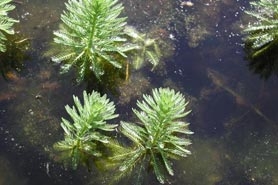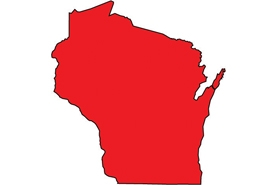Parrot feather
(Myriophyllum aquaticum)
Native to South America, but introduced nearly worldwide. Stems can be up to five feet long and trail along the ground or water surface, becoming erect and leafy at the ends.
Other names for this plant include:
- Common names: parrot feather watermilfoil, Brazilian watermilfoil, red-stemmed parrot feather
- Scientific names: Myriophyllum brasiliense; M. brasiliensis.
Classification in Wisconsin: Prohibited
- Ecological Threat
-
- Invades shallow lakes, ponds, ditches and backwaters in rivers; will colonize all shallow waters, forming dense mats of vegetation that can entirely cover the water's surface.
- Tough stems make it difficult to boat, swim, fish or water ski; it provides ideal habitat for mosquito larvae, and the plant's mass can cause flooding.
- Identification
-
Leaves: Emergent leaves are bright blue-green, stiff and two to five centimeters long, arranged in whorls of three to six leaves around the stem and divided into 12-36 leaflet pairs; underwater leaves are often decayed, but if present, they are limp, 1.5-3.5 cm long and are divided into 10-15 leaflet pairs per leaf.
Flowers: Tiny (0.5 mm) flowers with four white sepals occur individually on short stalks at the base of the emergent leaves; male and female flowers are on separate plants, but only female plants are found in North America.
Fruits & seeds: Because only female plants in North America exist, no fruits are produced here. Spreads through fragmentation of the stems and rhizomes.
Roots: Many, thin, from rhizomes.
- Distribution
-
Currently, there have been no reports of parrot feathers in Wisconsin. Have you seen it? Please send us a report.
- Control
-
Mechanical: Attempting control by manual or automated means tends to spread the plants and should only be conducted in small, contained water bodies. Draining a pond in the summer achieved control in one instance, but draining may not gain power in winter.
Chemical: Control with herbicides is complex because the emergent stems and leaves have a waxy cuticle that repels herbicides. Chemicals used successfully against parrot feather watermilfoil include diquat, diquat and complexed copper, endothall dipotassium salt, endothall and complexed copper, and 2,4-D. If using glyphosate formulated for aquatic use plus a surfactant, apply during the low water levels of summer and fall for complete coverage. Consult with your natural resources department before beginning herbicide control.
Biological: Plant-eating sterile grass carp find parrot feathers unpalatable due to the plants' stern, woody stems and high tannin content.
- Resources
- Sources for content:
- Czarapata, Elizabeth; Invasive Plants of the Upper Midwest: an illustrated guide to their identification and control. The University of Wisconsin Press. 2005. Pg. 147
- Swearingen, J., K. Reshetiloff, B. Slattery, and S. Zwicker. 2002. Plant Invaders of Mid-Atlantic Natural Areas. National Park Service and U.S. Fish & Wildlife Service, 82 pp. Invasive Plants of the Eastern U.S. Parrot Feather Watermilfoil.



